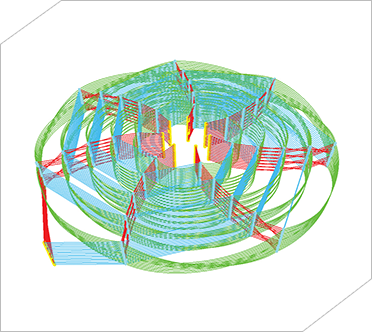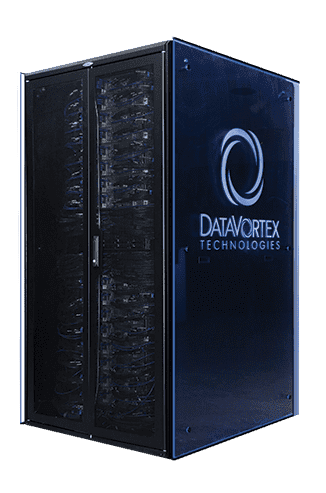Data Vortex: Partnering to revolutionize computing.

Solution Spotlight
Customer
Solutions
- Design and Development
- |
- Manufacturing
- |
- New Product Introduction
- |
- Supply Chain Solutions
- |
- Sustaining Services
Product
Markets
- Industrial
Blazing a new trail to solve the world’s most data-intensive problems.
In high-performance computing, no matter how fast the processors, answers can only come as quickly as the network between them allows. Dr. Coke Reed had an ambitious idea for solving that problem. See how collaboration with Plexus helped him prove the concept and bring a completely new kind of computing to the market.
Mathematician Coke Reed had a revolutionary idea.
Dr. Coke Reed, with Polish mathematician, Dr. Krystyna Kuperberg, had just solved a half-century-old mathematical challenge — “Problem 110” by Stanislaw Ulam — dealing with the movement of particles in a specific kind of whirlpool pattern. Now, as he sat one day taking in the beauty of Rocky Mountain National Park, Dr. Reed wondered, what if you applied those same dynamical principles not to particles, but to the flow of data? What if the solution to “Problem 110” could be leveraged to create a new kind of computer?
While at Rocky Mountain National Park, Dr. Reed wondered if his breakthrough in dynamical principles could be applied to data instead of particles.
A fully integrated partnership.
Dr. Reed knew this could mean a significant leap in supercomputer speed and performance, but the idea was still only a concept. Dr. Reed needed engineering expertise to help prove that the concept could work as a physical machine. That’s why, in 2008, he partnered with Plexus. In close collaboration, Dr. Reed and Plexus Senior Principal Engineer Mike Ives worked to translate the mathematical solution into an engineering solution. Mike worked to gain understanding of Dr. Reed’s patents, then implemented a hardware description language (HDL) simulation that successfully proved Dr. Reed’s initial concept. From that point on, Plexus and Data Vortex have been true partners, collaborating closely to make the revolutionary Data Vortex system a reality.
The project had a startup mentality — together with Dr. Reed, we essentially bootstrapped a new supercomputer. Because funding depended on getting private investors excited, we had to prove ourselves at every stage. First, that meant successful simulation just to prove the concept. Then we had to get the concept to fit on a physical FPGA, build a small-scale prototype, measure performance and leverage the data into support for a full-scale hardware prototype. By 2011, the Data Vortex and Plexus teams were able to design, build and deliver three DV102 beta test systems to customers. One went to The University of North Dakota, one to the Texas Advanced Computing Center at the University of Texas, and the third was installed at one of our own Plexus Design Centers.
At every step, Plexus worked side-by-side with Dr. Reed and his growing team to bring the Data Vortex concept into reality.
A new kind of supercomputer.
The unique design of Dr. Reed’s Data Vortex network wasn’t your average incremental step in the evolution of computing technology. This was a huge stride — a breakthrough capable of freeing scientific discovery from the limitations of traditional computing.
The Data Vortex network is a self-routing dynamical system that allows for much faster processor-to-processor communication. It’s scalable with no appreciable increase in latency because it moves small packets in a congestion-free network. It simply isn’t possible to achieve this using a crossbar-based network. The result is that the system delivers huge performance improvements for applications that require massive data movement. For certain problems, a Data Vortex system of equal size has a 32–100 times performance improvement over a comparable system with the same number of x86 cores.
Wherever vast amounts of information need to be processed — academic and scientific research, government and other big data and artificial intelligence applications — Data Vortex can make answers possible more quickly and efficiently than traditional computing. Several Data Vortex systems are now in place around the United States at government and academic sites, including the Department of Energy, Center for Advanced Technology Evaluation (CENATE) at Pacific Northwest National Laboratory, and the Center for Research in Extreme Scale Technologies (CREST) at Indiana University Bloomington.
The Data Vortex system excels at solving very large problems by allowing massive data movement between processors.

Continuing the innovation.
With Data Vortex, Plexus truly began on the ground floor of an exciting breakthrough in high-performance computing. Larger computer manufacturers hadn’t been willing to work with such an early-stage concept. But at Plexus, we were eager to take on the challenge. Our team understood the significance of what Dr. Reed’s vision could accomplish, and we were willing to invest in exploring the idea along with him. In fact, it was just the kind of discovery, invention and difficult problem-solving we thrive on.
To this day, the relationship between Data Vortex and Plexus is uniquely collaborative. The Plexus team takes part in installations, supporting Data Vortex customers face-to-face. Our own Mike Ives and Senior Project Manager Bill Stube often present on behalf of Data Vortex at industry events or in customer meetings. Data Vortex even brings prospective customers to our Plexus facilities to showcase our ability to deliver — and our flexibility to ramp up to support their growing needs, including production manufacturing.
In many ways, Data Vortex counts on Plexus as their own research and development department. We have co-authored several patents with Data Vortex, and they’ve trusted us to expand their product line to include full systems, switches and interface controllers. We also continue to develop their next generation of products, tapping into every area of our service offerings.
Most of all, the longevity of our relationship speaks to just how much Data Vortex trusts Plexus to come through for them. For our part, we are proud to be part of this revolution in high-performance computing. We’re grateful for the trust Dr. Coke Reed and his team have placed in us. And we’re looking forward to the innovations we’ll continue to help Data Vortex bring to market.

We are proud to be part of this revolution in high-performance computing and we’re looking forward to the innovations we’ll continue to help Data Vortex bring to market.


